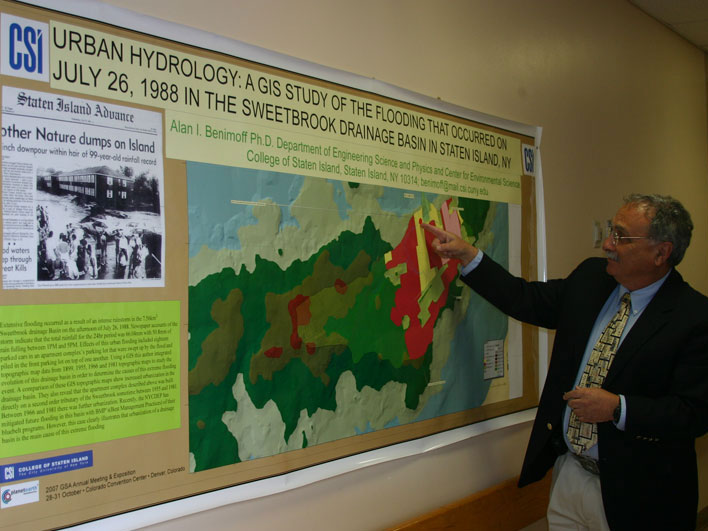In July 1988, the Sweetbrook drainage basin on the South Shore of Staten Island was inundated with over 2.6 inches of water in a 24-hour period, two inches of which fell in a four-hour period. As a result, the area flooded, sweeping up 18 cars that were parked at a nearby apartment complex, piling them one on top of each other.
Since then, the New York City Department of Environmental Protection (NYCDEP) has made infrastructural changes to the area to prevent further flooding, but Alan Benimoff, a geology professor at the College of Staten Island (CSI) decided to find out why the area flooded in the first place. “I decided on my own to go back and see what caused that flooding,” Benimoff explains, “and I was amazed to see that there was a whole bunch of urbanization that took place, where they actually built a garden apartment complex on a stream bed…. I couldn’t believe it.”
Using Geographic Information System technology, which allowed him to analyze topographic maps and data on the basin from 1899, 1955, 1966, and 1981, Benimoff found that the area was covered with vegetation as late as 1966. “What they did,” he says, “was they just built on that [area] and when you remove the vegetation and replace it with asphalt and concrete, infiltration of the rain is reduced and runoff is increased. Since urbanization tends to decrease the lag time between rainfall and runoff, the water enters the stream quickly.” So, in essence, the flood was caused by the over-urbanization of the area.
Benimoff, who recently presented these findings at the annual meeting of the Geological Society of America, continues to study Staten Island’s South Shore and its flood potential, particularly with attention to the affects of future hurricanes on the area, says that he hope to share his findings, which were presented recently at the 119th Annual Meeting of The Geological Society of America, with NYCDEP officials to bolster that agency’s flood prevention efforts.
Another group that will benefit from Benimoff’s research will be his students at CSI. Benimoff notes that he will share his findings in the graduate course that he teaches on soils and geohydrology, which is part of the College’s Master’s program in Environmental Science. “I plan to use this [research] as a case study about how to deal with storm water management and how to avoid problems like this,” Benimoff says. Adding that many of his students will eventually graduate and move to other parts of the U.S., Benimoff stresses that this knowledge will help them to prevent flooding problems elsewhere.


![[video] CSI Geologist Analyzes Staten Island’s “Rocky” Past and Future on NatGeo TV’s Prestigious “Known Universe” Series](https://csitoday.com/wp-content/themes/Extra/images/post-format-thumb-text.svg)














